How to choose a fan heater: what parameters to navigate when choosing equipment
The best option for quick heating of cold rooms in the offseason is the use of fan heaters. The simple design and low cost of these devices made them mega-popular among citizens. But choosing the right one is not so easy - in a huge assortment from various manufacturers it is easy to get confused.
We will help you figure out how to choose a fan heater for heating, for which we will study the options for their device and the features of application in various conditions.
We also give the main criteria that affect the choice of the device and give practical recommendations to future customers.
The content of the article:
Fan Heater Classification
Fan heaters are classified by installation method, scope and heating element. By the type of regulation they can be divided into remote and mechanical.
Fan heaters with a remote control are more expensive, but they allow you to manage their work without getting up and without taking off a warm blanket.
Next, the features of the devices in the context of their classification are analyzed.
By application
By scope of application, fan heaters are divided into:
- industrial;
- household.
Industrial models, unlike household ones, are designed for round-the-clock use without affecting the durability of the work.
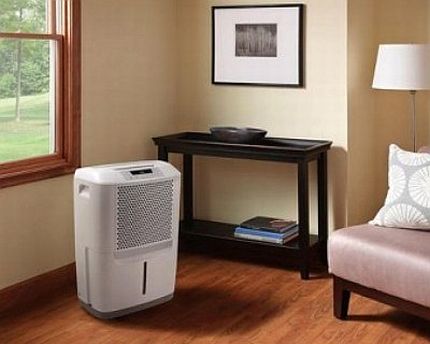
The power of each category is also different due to the possibilities of home electrical networks.
Automation on apartment electric meters works even with long-term loads of 3.5-4 kW, so the power of domestic fan heaters rarely exceeds 2.5 kW.
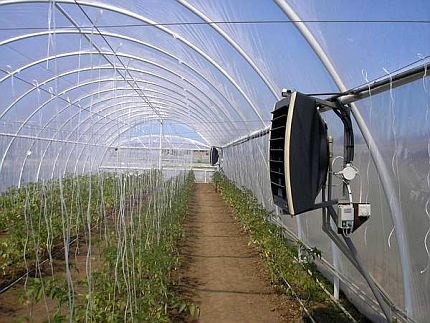
Heaters for industrial use are not limited in power consumption and usually have the ability to connect to a network voltage of 380 V.
High-performance space heating systems are sometimes called heat guns.
By the nature of the installation
By the method of installation, fan heaters are classified into the following types: stationary and mobile.
Stationary, in turn, are divided into:
- floor;
- wall mounted;
- Ceiling
- combined.
Mobile devices can be installed anywhere in the room and even hung on hooks. These include desktop heating systems.
Mobile fan heaters are compact, lightweight, and their power is usually limited to 2-2.5 kW.
Floor fan heaters often look like vertical columns. Compared to mobile devices, they produce less noise and are more productive.
Some floor models have a movable swivel housing that allows you to direct the flow of warm air in several directions. In the summer they can be used as simple fans.
Wall-mounted fan heaters are reminiscent of the indoor unit of an air conditioner, but they do not supply air flow to the side, but down. They are often used for a thermal curtain over the entrance doors to the room. Wall models are controlled using the control panel and mechanically.

Ceiling fan heaters direct the flow of warm air in all directions at the same time, therefore they are recommended for heating large rooms with high walls.
Stationary fan heaters are relevant in rooms with a constant need for heating. And if heat is needed for a couple of weeks or just for heating your legs, then the mobile option is the best choice.
By heating element
The heating element in the fan heater can be as follows:
- TEN;
- spiral;
- ceramic heater;
- water heat exchanger.
Devices with a water heat exchanger are usually hung on the walls and integrated into the room heating system. Their fan serves to accelerate the circulation of air in the room, if necessary, rapid heating.
A nichrome wire spiral is the oldest and cheapest heating element that has been used for over 100 years. Its surface is heated to 800 ° C, which leads to the burning of dust contained in the air and the appearance of a slight burning smell.
Burning out the spiral can lead to the ignition of the device, therefore this type of fan heaters is the most fire hazard.
Heating elements have the form of a tube that contains a nichrome wire inside and is filled with a heat-conducting substance. The temperature of its surface rarely exceeds 450 ° C, so the dust does not burn out upon contact with the tube.
This makes the heater more comfortable and safe compared to the spiral, no odors arise during its operation. The cost of fan heaters with heating elements is slightly higher than with spiral heaters.
Ceramic heaters have radiator grilles made of semiconductor material, the surface of which is made of heat-resistant glass ceramics. These products are obtained by spraying powder on a metal frame, followed by sintering in a furnace.
The surface temperature of ceramic heaters does not exceed 100-150 ° C, and high heat transfer is ensured due to the large area of contact of air with a hot coating. Such heaters are safe to operate, but require regular manual cleaning and are more expensive.
Device and principle of operation
A fan heater, by definition, must generate heat that is carried around the room by a fan.
Therefore, any such device consists of three required components:
- Body.
- A heating element.
- Fan.
The housing of low-cost models is made of cheap plastic, which during long-term operation can be deformed and even fused. It is advisable to purchase fan heaters in a metal shell, which is able to limit ignition in case of overheating of the internal elements.

The fan can have different power. The higher it is, the faster air is blown through the heating element, lowering the temperature of its surface. The impeller rotation speed is often changed using the knob.
Fans can be of two types:
- axial (lobed);
- tangential.
Axial fans have 3-8 blades of the usual look, which are made of plastic or metal. Such impellers are mounted on portable models. Axial fans are noisy, but unpretentious in maintenance. They should be periodically lubricated with machine oil.
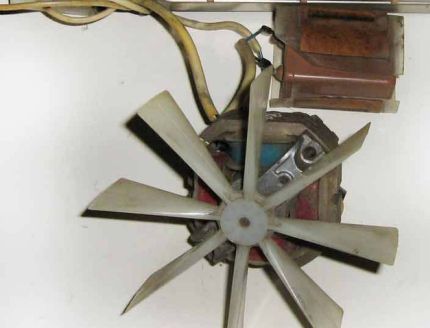
Tangential fans have the form of a cylinder with 20-30 blades in the form of longitudinally arranged strips. They are placed mainly in wall and vertical models.
The cylindrical design provides quiet operation and high performance. The disadvantage of tangential fans is the need for periodic cleaning.
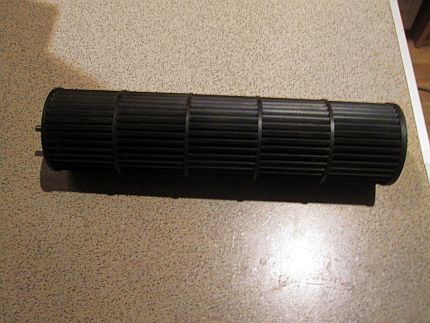
The heating elements are located in front of the impellers, which allows them to cool evenly.The rear position of the fan also contributes to the capture of more air.
In addition to the main components, heaters can have additional equipment that extends their functionality.
Fan heater selection criteria
Choosing a fan heater is not an easy task. The product range is large, and prices for similar models can vary significantly.
Next, we will consider what characteristics of the heater to pay attention to when buying, in order to choose the most useful model and not overpay for unnecessary functions.
The main factors that determine the choice of fan heater are:
- power consumption;
- type of heating element;
- availability of additional functions;
- operating modes.
The influence of each of the listed factors on the choice of a heater should be considered in more detail.
Criterion # 1 - power consumption of the device
Only 10-12% of fan heaters on the market have a capacity of less than 2 kW, but they also have their own customers.
Heaters with a power of 1-1.5 kW are recommended to be purchased in such cases:
- The house has an old aluminum wiring, which can catch fire from high loads.
- Simultaneous inclusion of 2-3 fan heaters in one room or apartment is required.
- The size of the heated room does not exceed 10 sq.m.
- The device will be used for additional heating with the existing heating system.
The minimum power of the fan heater is calculated based on the norm of 1 kW per 25 cubic meters. premises.
It must be remembered that ordinary sockets are designed for a maximum current of 16A, which corresponds to a power of 3.5 kW equipment. Therefore, heaters with a consumption of more than 3 kW cannot be used for a long time at home.
Criterion # 2 - type of heating element
The most common are fan heaters with heating elements in the form of a heating element, a spiral and a ceramic lattice. Budget models of heaters are equipped with a nichrome spiral.
You can choose such a heater in such cases:
- There is no financial opportunity to buy a more expensive model.
- The device will be constantly in sight.
- Using a heater will not be around the clock.
- Fan noise is not critical.
Cheap fan heaters with a nichrome spiral are quite fire hazardous, so you need to buy them only under the listed conditions.
The best option for a heater is a device with a ceramic heating element.
They are more expensive than spiral ones by 20-50%, but have a number of advantages:
- They have high fire safety.
- They can be operated around the clock.
- Durable
- Do not burn airborne dust.
Fan heaters with a heater are located in practicality between spiral and ceramic. You can choose them if you have good additional functionality and reasonable prices.
Criterion # 3 - fan and heater operating modes
The number of fan heater operating modes directly affects its resource and profitability.
Typically, heaters have three schemes for regulating their work:
- change in fan speed;
- temperature control of the heating element;
- automatic maintenance of the set room temperature by periodically turning the device on and off.
Changing these parameters can occur by discrete or smooth movement of the adjusting knob. A more precise setting allows you to create the desired temperature regime in the room, without wasting excess electricity.
To change the fan rotation speed, you can use a special device - a regulator, the device of which and the connection rules we reviewed here. The regulator can also be used in the assembly of a homemade heater.
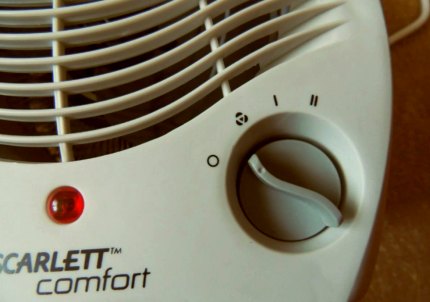
Some models of the fan heater have a built-in timer that allows you to heat the room just before a person arrives.
Criterion # 4 - additional functionality of devices
The basic functionality of fan heaters usually involves the presence of knobs for controlling the power of the heating element and the speed of rotation of the impeller. But manufacturers equip heaters with other devices so that their products have advantages over competitors.
The presence of additional functions for the fan heater is an indisputable advantage, therefore, within the existing budget, it is recommended to buy a heater with the maximum number of them. But first you need to assess the real need for additional equipment.
Such additional equipment includes:
- Swivel mechanism that allows you to direct warm air in different directions.
- Low noise bearings.
- Protection sensors that turn off the device when capsizing or overheating. They are relevant for families with small children and pets.
- Thermostat.
- Splashproof housing.
- Humidifier.
- Ionizer.
- Remote Control
- Air filters.
Cold mode is also actively used (without turning on the heating element).
As for such a function as ionization, experts recommend buying a separate device designed for the ionization process for these purposes. Arguing that special devices designed to ionize the air do a better job of this.
Recommendations for choosing a household ionizer we gave in this article.
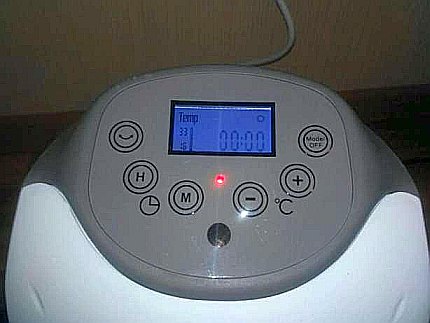
Each additional equipment adds a certain amount to the cost of the fan heater, so the heater’s functionality is limited only by the planned purchase budget.
You doubt the feasibility of buying this type of heater registered? We recommend that you familiarize yourself with the material in which we have provided a detailed comparison of fan heater and convector.
Popular manufacturers of fan heaters
To protect yourself from buying a low-quality fan heater, it is advisable to purchase products from trusted manufacturers who are worried about their image.
Below is a list of the most famous brands of fan heaters that have proven themselves among consumers:
- Calore. The company has floor and table models with a compact design and good performance. They are equipped with protection against overheating, therefore they are safe to operate.
- Ballu. The heaters of this company are represented mainly by small but powerful models, which are equipped with power control knobs.
- Electrolux. The fan heaters of the company are famous for their unusual design. Cases of devices are made of environmentally friendly heat-resistant materials, providing additional protection.
- Timberk. The company produces fan heaters with spiral and ceramic heaters. Most models are equipped with additional features. There are wall options.
- Polaris. Heaters are represented by wall, floor and mobile models. Advantages are a wide range and diverse design.
- Stadler form. A feature of this company is the production of heaters of a rectangular and perfectly round shape. The original design is combined with quality ceramic heaters.
- Mystery. This company offers many inexpensive floor-standing vertical models equipped with timers and thermostats.
Some companies release up to 10 new modifications per year.
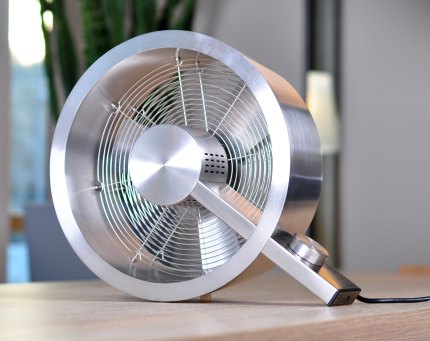
The list of worthy companies is not limited to the proposed options and is constantly updated with new manufacturers of quality products.
Does the cost of a fan heater from a well-known manufacturer seem overstated to you? To heat a garage or other utility room, you can make a homemade heater based on a fan like a heat gun. To assemble devices, you can use improvised materials.
Detailed instructions for making popular homemade products can be found in the following articles:
- How to make a fan heater with your own hands: a briefing on the manufacture of a homemade device
- DIY heat gun: manufacturing options for different types of fuel
- Do-it-yourself electric heat gun: the pros and cons of homemade + assembly instructions
- Garage heaters: sound advice on choosing the best heater
Instructions for use
Before buying a fan heater, you should read the tips for operating fan heaters.
A list of useful knowledge is given below.
- If it is necessary to heat the legs in the office, a cheap heater with a power of 1-1.5 kW with a spiral heater is suitable.
- Heaters for continuous use should be equipped with trip automatics in case of overheating or overturn. A thermostat is also desirable.
- To heat several rooms, a fan heater is required in each room.
- Do not place the device on blankets, pillows or other surfaces that impede its cooling.
- Conventional fan heaters must not be used in showers and rooms with high humidity.
- You can not direct warm air to plastic interior items.
Compliance with these recommendations will save money, keep equipment operational and prevent possible accidents.
Conclusions and useful video on the topic
The videos offered are comparative reviews of fan heaters from their sellers. They will show the operation of heaters with real examples and allow you to evaluate their appearance in a home environment.
Stadler Form Design Heater Range:
Features of operation of compact fan heaters:
Overview of various air heaters:
Choosing a fan heater is not an easy task, especially when buying a device of an average and premium price category. If you give preference to less expensive models with wide functionality, you can stumble on their low quality.
Following the suggested tips will help you figure out which type of fan heater is better for acquiring specific tasks without spending money in vain.
Do you use a fan heater for heating? Tell us which model you purchased and what parameters were important to you when buying? Add a photo of your fan heater, write your recommendations in the comments section - your experience will be useful to people who are now choosing a fan heater for their home.

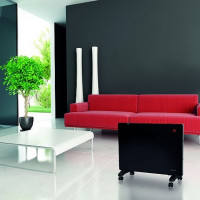 What is better to buy - a convector or fan heater? Comparative review
What is better to buy - a convector or fan heater? Comparative review 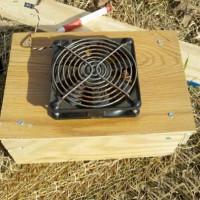 How to make a fan heater with your own hands: a briefing on the manufacture of a homemade device
How to make a fan heater with your own hands: a briefing on the manufacture of a homemade device 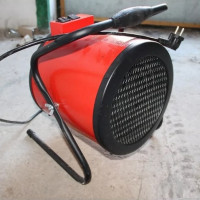 Electric heat gun: types, how to choose, an overview of the best manufacturers
Electric heat gun: types, how to choose, an overview of the best manufacturers 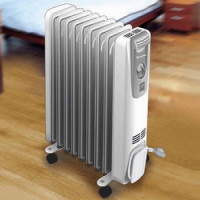 Which heater is better to choose for home and apartment: a comparative overview of units
Which heater is better to choose for home and apartment: a comparative overview of units 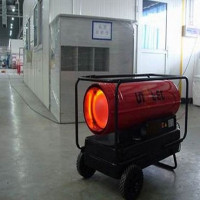 Thermal gas guns: device, selection options, an overview of popular manufacturers
Thermal gas guns: device, selection options, an overview of popular manufacturers 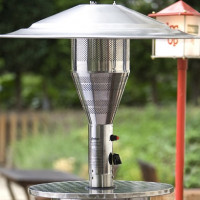 How to choose a gas heater for a summer residence: choosing a device for outdoor heating
How to choose a gas heater for a summer residence: choosing a device for outdoor heating  How much does it cost to connect gas to a private house: the price of organizing gas supply
How much does it cost to connect gas to a private house: the price of organizing gas supply  The best washing machines with dryer: model rating and customer tips
The best washing machines with dryer: model rating and customer tips  What is the color temperature of light and the nuances of choosing the temperature of the lamps to suit your needs
What is the color temperature of light and the nuances of choosing the temperature of the lamps to suit your needs  Replacement of a geyser in an apartment: replacement paperwork + basic norms and requirements
Replacement of a geyser in an apartment: replacement paperwork + basic norms and requirements
Choosing a fan heater is really not an easy task. By the principle of cheapness, you won’t get away with it, because the budget model simply can not cope with the quadrature of the room. They are also not very safe. Especially if the apartment has small children. My husband and I were looking for a suitable one for a long time. In the end, they just bought a wall split system. In winter, our batteries do an excellent job of maintaining heat, and in the off-season they are replaced by a split system.
In our house, a budget ceramic fan heater with power control, a thermostat and a rotary mechanism saves from the cold. Functions are not enough, but they perform the main task, and this is enough for me. I used to not really like to use heaters because of their significant drawback - the ability to “burn oxygen”. But this, I believe, is a relic of the past, and now there are a lot of modern models at an affordable price.
Ceramics work well, and heaters with such an element are light and compact. But the spiral, this is probably already yesterday - I would not advise buying.
At our place, communal services like to pull with turning on the heating in the fall and, on the contrary, turn it off ahead of time in the spring. Maybe the temperature gets under some of their indicators and standards, but it feels uncomfortable - it's cold. I plan to buy a heater, while leaning toward a fan heater with a ceramic heating element. I wonder how quickly they warm the room and how much they dry the air?